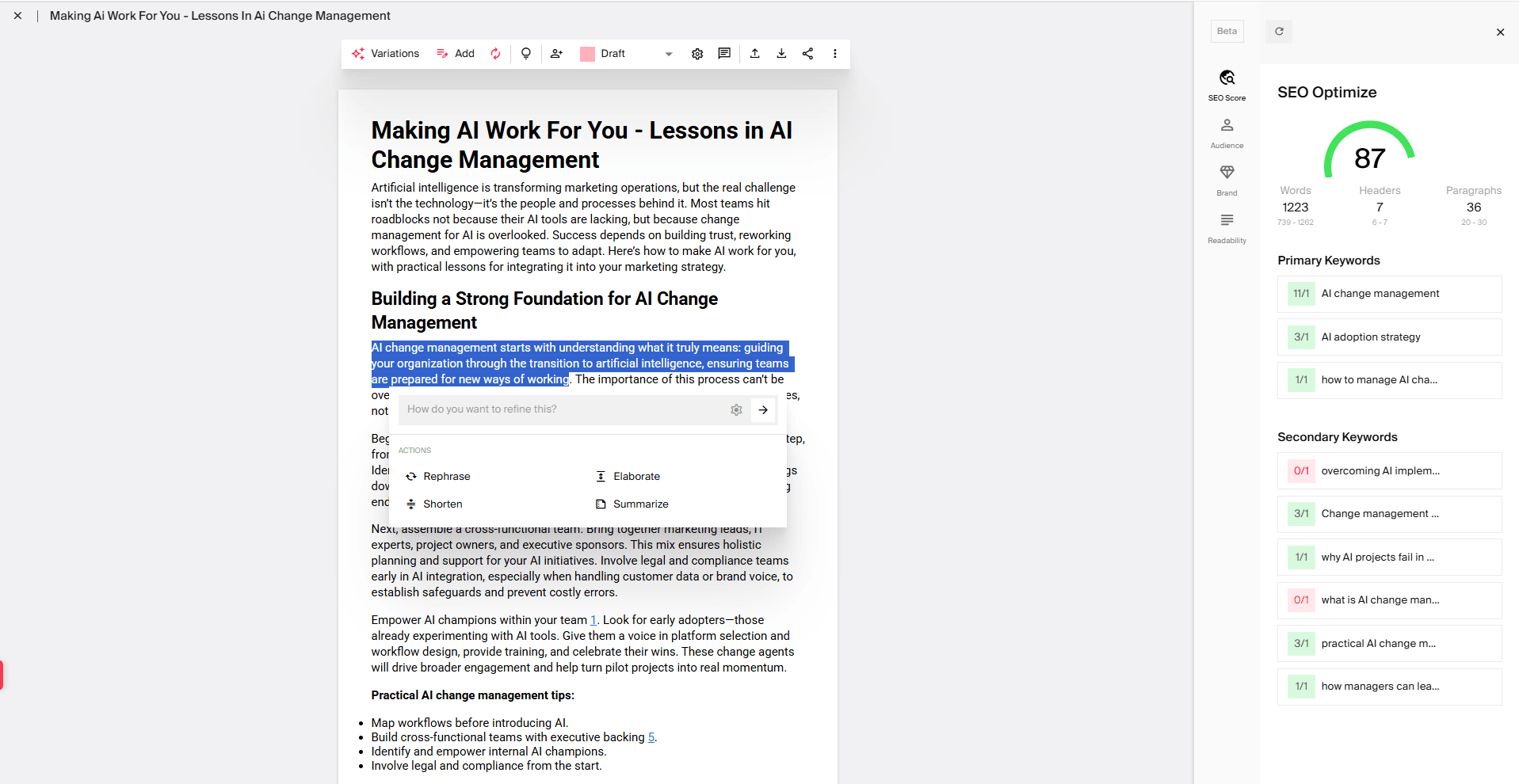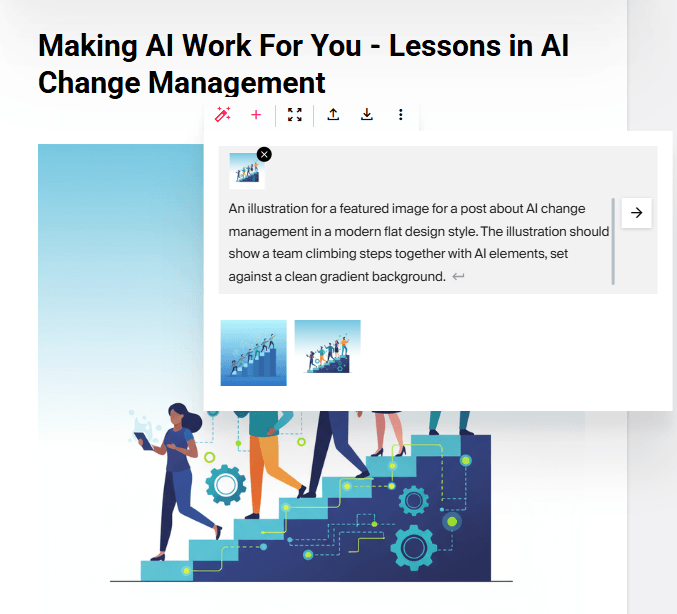AI at Work
AI + SEO: 7 Proven Ways to Improve SEO Content Writing with AI

Neelam Goswami · Content Marketing Associate
October 31st, 2025 · 17 min read

AI tools now automate keyword research, content optimization, and analytics across SEO workflows. Over 65% of businesses report better SEO results using AI.
Yet, for those who haven’t embraced AI, critical questions loom: �
Can AI-generated content actually help us rank in Google search? Does Google penalize AI-generated content?
Let's cut through the confusion and look at how successful teams are using AI to improve their search rankings.
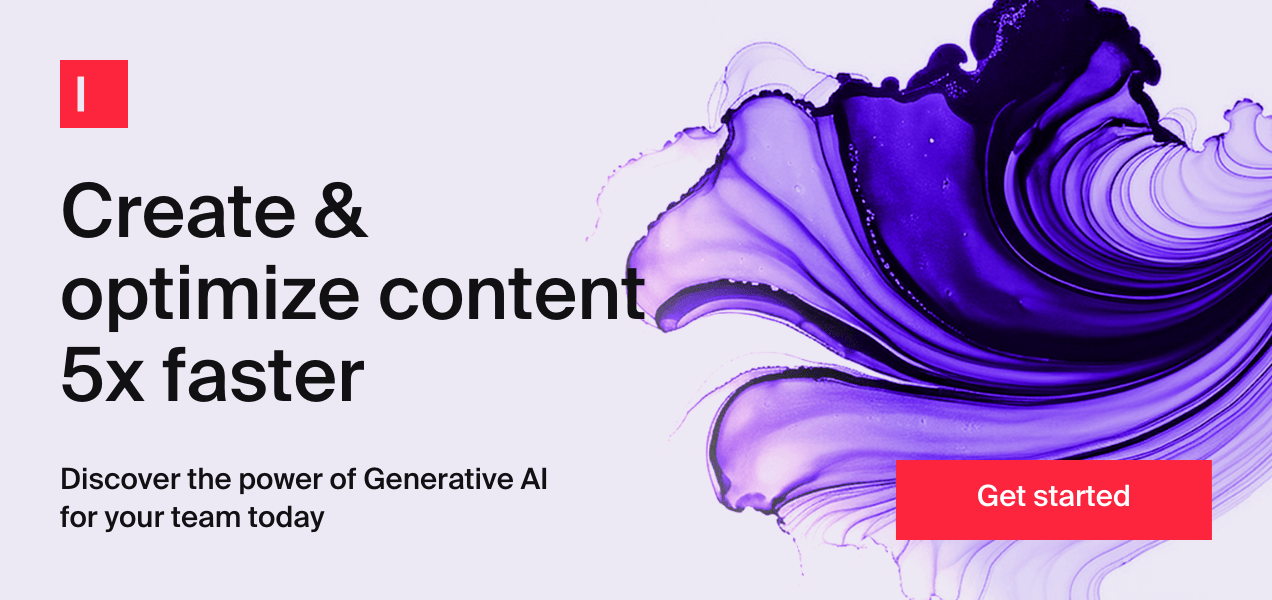
Does Google penalize AI content?
The short answer: No. Google rewards high-quality content regardless of how it was created.
As long as AI-generated content meets E-E-A-T requirements (Experience, Expertise, Authoritativeness, Trustworthiness) and provides value to users, it can rank just as well as human-written content.
Google only penalizes content that uses AI or automation to spam search engines and manipulate rankings. Ethical AI use is fully compliant with Google's guidelines.
More myths about AI and SEO content →
“AI content can’t rank on Google.”
Reality: AI-generated content can rank just as well as human-written content when it meets E-E-A-T standards and provides genuine value.
The adoption rate reflects this opportunity: 51% of marketers now use AI to create and optimize content.
“You need to disclose AI usage to Google.”
Reality: Google doesn't require disclosure. They only care that content is helpful, reliable, and people-first.
Why use AI for SEO content writing?
Great SEO content puts people first but respects algorithmic rules. AI helps marketing teams deliver on both.
Creating people-first content: Readers want unique insights, original research, and credible guidance. Often, this valuable knowledge sits scattered across different systems, in team members' minds, or buried in documents. Enterprise AI marketing platforms can connect these disparate sources and transform that intel into compelling, informative blogs that genuinely serve your audience.
Following algorithmic rules: AI also handles the technical optimizations that help content rank, like keyword additions, semantic variations, readability improvements, and ensuring content directly answers search queries. These optimizations happen during the writing process, not as an afterthought.
Case in point: Typeface helps enterprises scale SEO content with AI agents and workflows. It connects your teams' insights to create reader-focused content while surfacing keyword suggestions and weaving them — plus any keywords you add from your own research — into blog content naturally.
Beyond SEO-optimized blog posts, you can create complementary visual assets like featured images, videos, and social snippets — on one collaborative platform.
Customizable creation-review-publication workflows add to the cohesive experience by eliminating bottlenecks and streamlining collaboration while improving efficiency across every stage of content production.
7 ways to use AI for creating SEO content that performs
There are many ways in which generative AI can help create content optimized for search. Let's look at how you can use AI for SEO content writing.
1. Generate new SEO blog posts from scratch
AI can create high-quality first drafts in minutes, cutting blog writing time by 50-90% and helping you publish more consistently.
How it works
AI content generators research, outline, and draft SEO articles at unmatchable speed. What takes teams hours or days to create takes AI minutes. Rather than writing every word, you can guide AI to create relevant content, then spend your time editing and optimizing an already well-written (and well structured) article.
In Typeface, this means:
You give Web Agent, our AI agent for web page and blog creation, basic blog details like topic, audience, word limit, tone, and keywords. You can add your own keywords or turn on AI keyword suggestions for instant ideas.

Web Agent can use live web sources or your proprietary content sources (research reports, case studies, specific URLs, etc.) to generate content.
Enable web search to pull insights and citations from authoritative sources; or
Attach your own documents or URLs to help the AI create original, well-informed content.

Generate an outline and refine it directly in the document

Generate your full blog. Review it, checking for:
- Accuracy
- Keywords
- Brand voice alignment
- Audience alignment
- Editorial violations
Use the built-in editor to enhance sentences and paragraphs.
![AI blog creation automate editing]()
5. Add an image/video clip from your Assets library. Or generate a fresh image or video in Typeface.
![Generate blog feature images with AI]()
Assign the blog for review. The next editor in line receives notifications through Slack and email.
![AI blog generation]()
Publish to WordPress or Contentful directly. Click to see all integrations.
Real example
A Fortune 500 energy provider used Typeface to generate content first, then refined it with human editing. The result: a 65% increase in blog engagement compared to traditional content, along with lower production costs.
Why this matters
Websites with active blogs have 434% more indexed pages and 97% more inbound links than those without. AI transforms the lengthy blog writing process into a smarter, faster workflow that helps maintain a consistent publishing schedule.
2. Generate SEO meta tags for blogs and web pages
No one looks forward to writing meta tags for hundreds of product pages, blog posts, and landing pages. AI takes care of this critical (but cumbersome) SEO task for you.
How it works
AI analyzes your blog or webpage content and generates meta titles, meta descriptions, and keywords. In practice, this means you paste the particular content or URL and prompt Web Agent to create SEO meta tags.
Real example
Whether you’re creating 30 or 3,000 service pages, Web Agent instantly optimizes each with meta tag suggestions to improve visibility and engagement.
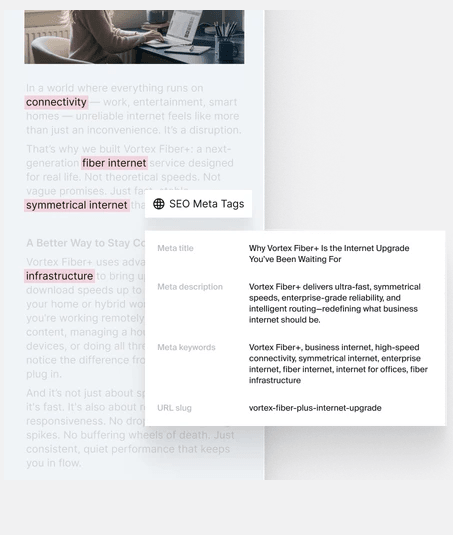
Why this matters
As you publish more content, creating meta tags manually becomes a bottleneck. It can lead to meta tag optimization being deprioritized or done poorly. With AI, you don’t have to choose between speed and quality, no matter the scale.
3. Create brand-aligned and audience-focused content
Trained well, AI can create content that connects with your audience and reflects your brand’s identity and values.
How it works
A significant aspect of user experience in SEO is ensuring that your content is aligned with your brand identity and resonates with your target audience. Your brand voice and style should be consistent across all content pieces to maintain credibility with your audience.
Does the content match the user's intent?
Does it speak to the right audience?
Does it reflect your brand's values and help build trust among your audience?
These are some questions that must be answered whenever you talk about high-quality SEO content.
Generative AI for SEO content can be trained to mimic your brand’s unique tone and style, which reinforces your brand image, making it more memorable and trustworthy.
When using Typeface, you have the option to save your brand kit. This includes your brand values, tones, and writing rules such as what terms and phrases to avoid, which abbreviations to avoid, and more. You can also save your brand voice on the platform.
Similarly, you can save target audience segments by connecting your CDP or CRM to Typeface. Or you can add segments manually, defining them by demographics, interests, and spending behavior.
Then, the brand kit and target audience can be applied to your AI generations, ensuring that the output closely aligns with your set requirements. (Note: You can evaluate how well your content aligns with your brand kit by using Typeface’s Content Explainability tool).
Learn more about content explainability: Boost content impact with actionable intelligence.
Real example
Typeface’s enterprise users have rolled out a content creation magic carpet across their brands and markets, bringing personalized, high-value content within easy reach of marketing teams.
Why this matters
Over three-quarters of customers report that personalized messages play a key role in their brand choices. But brands are struggling to meet expectations, with over 60% of customers saying most companies treat them as numbers rather than individuals.
AI-led content customization offers a powerful way to connect with key audience segments by creating relevant, valuable content, using keywords that boost visibility, and communicating in tones and languages that resonate.
4. Optimize for Featured Snippets
Featured snippets and AI overviews can greatly increase your visibility and clicks. Traditional SEO helps, but answer engine optimization follows its own rules — and AI tools can make it easier.
How it works
AI tools are built for readability, not snippet-style brevity. With proper prompting or training, though, they can create concise, scannable answers aligned with AEO best practices. Unlike manual writing, AI can apply these best practices consistently and at scale, saving both time and effort.
Real example
With AI accelerating first drafts, writers can focus on refining structure and applying AEO best practices that make content easier to discover and more useful to readers. Custom agents for FAQs and other optimizations further enhance performance in answer-driven search.
Why this matters
Search performance is tied to user behaviors, and those behaviors show signs of changing. Even as search shifts towards AI-driven experiences, creating high-quality, people-first content and keeping it up to date will remain core to SEO success. AI helps marketers do this efficiently and at scale, supporting both discoverability and genuine audience value.
5. Create locally relevant content
AI can apply audience context and local keywords to content, helping attract high-intent traffic and scale localization across markets.
How it works
Locally relevant content is especially valuable in industries where geography shapes customer needs. For example, airlines and hotel chains often adapt landing pages for different destinations and languages, while financial services firms create blogs addressing state-level tax laws.
With the right inputs, AI can help generate content tailored to specific regions or markets at scale. In Typeface, you can add audience demographics and interests to create content that reflects local queries and priorities.
Real example
Typeface customers can easily scale campaign assets across markets by creating visuals and messaging that reflect local sensibilities and experiences. The time and cost savings from AI-driven campaign localization are substantial.

Why this matters
Strengthening your local content strategy makes your brand feel more personal and accessible to customers while also boosting visibility in local search.
6. Generate article outlines
AI SEO content generators can create detailed outlines to speed up and scale blog, eBook, and article creation.
How it works
Outlining topics is a common practice among copywriters creating long-form content. It streamlines the writing process by organizing ideas and maintaining focus.
Using AI for outlines builds on this same principle. AI can quickly structure ideas into logical sections, from introduction to conclusion, drawing on web sources and any connected sources you provide.
Whether you’re creating content at scale, optimizing for SEO, simply looking for fresh ideas, AI can make the outlining process faster and more efficient.
In Typeface, the blog workflow starts with Web Agent creating outlines based on your article topics, keywords, and live web data (if enabled) or grounding documents or URLs.
Web Agent integrates keywords naturally into subheadings and paragraphs — something you'll notice when reviewing its outlines. When audience context is included, the result is even more targeted and relevant to readers’ needs.
Real example
Typeface users can generate blog outlines in seconds, drawing on live web sources for fresh, timely ideas. For in-depth, long-form content, it’s best to complement this with solid source material. From there, the content generation process flows smoothly, building on verified insights and facts to create engaging, well-structured pieces.
Why this matters
Even subject matter experts can struggle with deciding what to include in an article. A creative springboard helps. AI can assist by outlining topics, generating fresh ideas you might not have considered, and helping you get content out the door faster, without sacrificing depth or quality.
7. Repurpose your best content
AI can repurpose a compelling piece of content across platforms and formats, extending the reach of a thought leadership initiative, major win, launch, or PR campaign.
How it works
AI excels at transforming long-form assets into multiple formats. For example, it can turn a 20-page whitepaper into a blog series, video script, or social media snippets.
If it’s multimodal, like Typeface, it can work across text, audio, and video to generate fresh, on-brand pieces such as social clips, newsletter sections, or case study highlights — all in minutes.
Real example
A Typeface client increased content output by repurposing existing video and text assets into new SEO blogs and articles. AI-driven repurposing also reduced writing and publishing time, helping them get content out the door faster and keep a steady rhythm of communication.
Why this matters
Brands invest heavily in premium content like eBooks and research reports. Repurposing these high-value assets helps maximize their ROI. AI makes this process faster, more consistent, and more systematic.
Best practices for using AI for SEO content
From getting a first draft down quickly to turning research insights into a blog, AI can keep your content engine humming.
That said, AI is still a machine — it has no lived experience, emotions, or intuition. You can’t put it on autopilot, just as even human-created content requires review and refinement.
With that in mind, here are some best practices to follow when using AI for SEO content.
Balance AI automation with human input
The best SEO content comes from human-AI collaboration. While AI excels at generating drafts, conducting research, and optimizing content quickly, it serves best as a first-draft collaborator rather than a replacement for human expertise.
Think of it this way: AI handles 80% of the foundational work, from gathering keyword data to creating structured outlines and generating initial drafts. This foundation lets your team focus on what humans do best — adding original insights, refining the strategic narrative, and ensuring every piece aligns with your brand voice.
Build in authenticity and originality
A key challenge with AI-generated content is maintaining authenticity and originality. To drive real traffic and conversions, your AI needs to understand your business context and create high-quality, valuable content that meets search standards.
Make sure to integrate their own expertise and unique perspectives in your content. This could involve feeding AI with rich, proprietary insights or conducting original research to enrich AI-generated drafts. Also consider involving subject matter experts to review and enhance AI-generated content ensures factual accuracy and depth.
Set boundaries between AI and human work
As AI will always produce an output — even with limited input — it’s important to be intentional about what you ask it to create and to verify accuracy and completeness. Some content tasks, however, are still best left to your copywriters.
When not to use AI for SEO
Highly technical content requiring deep subject matter expertise
Content about breaking news or very recent developments
Personal stories or unique brand narratives
Original research and proprietary data analysis
Why Typeface
Using AI for SEO can help lighten the load on your team by automating routine SEO tasks. Leverage AI for generating outlines and first drafts, optimizing meta descriptions, and predicting SEO performance.
AI SEO tools ensure that your content is personalized for the right audience and reflects your brand values. They are best used as a complement to human creativity and insight. The key is to strike a balance.
To start crafting SEO-optimized blogs for your business, get a demo of Typeface and understand how it can transform the way your marketing team works.
FAQs
How much editing does AI-generated content need?
The level of editing depends on the task. For informational SEO blogs, minor tweaks should suffice while complex or original topics may need more additions and adjustments.
Every piece of AI-generated content requires human oversight to ensure quality and accuracy. Essential review areas include:
Factual accuracy - Verify claims, statistics, and references
Brand voice alignment - Ensure tone matches your brand guidelines
Content quality - Remove repetition, filler, and unnecessary fluff
Readability - Refine sentence structure and flow
Logical coherence - Strengthen transitions between ideas
Depth and originality - Add specific examples, anecdotes, data, and insights that AI can't generate
Can AI content help you rank faster than manual writing?
A blog can rank within hours, weeks, or not at all, regardless of whether it’s written by AI or a human.
Ranking depends on several factors: EEAT (experience, expertise, authoritativeness, and trustworthiness), backlinks, niche competitiveness, and ongoing SEO efforts. Even then, rankings fluctuate over time (fewer than 5% of websites maintain first-page visibility for a full year).
So, instead of focusing on ranking speed, think in terms of outcomes. Aim for short-term impact like increased traffic, engagement, or visibility from timely topics and long-term value like authority building, lead generation, and sustainable organic growth.
Do marketers report positive results with AI content?
According to study findings, yes. 39% of marketers reported an increase in organic traffic after publishing AI-generated content, and 33% said it performed better than human-written content. However, the best results came from a hybrid approach: refining AI drafts, adding original research, and layering human insight to strengthen the final output.
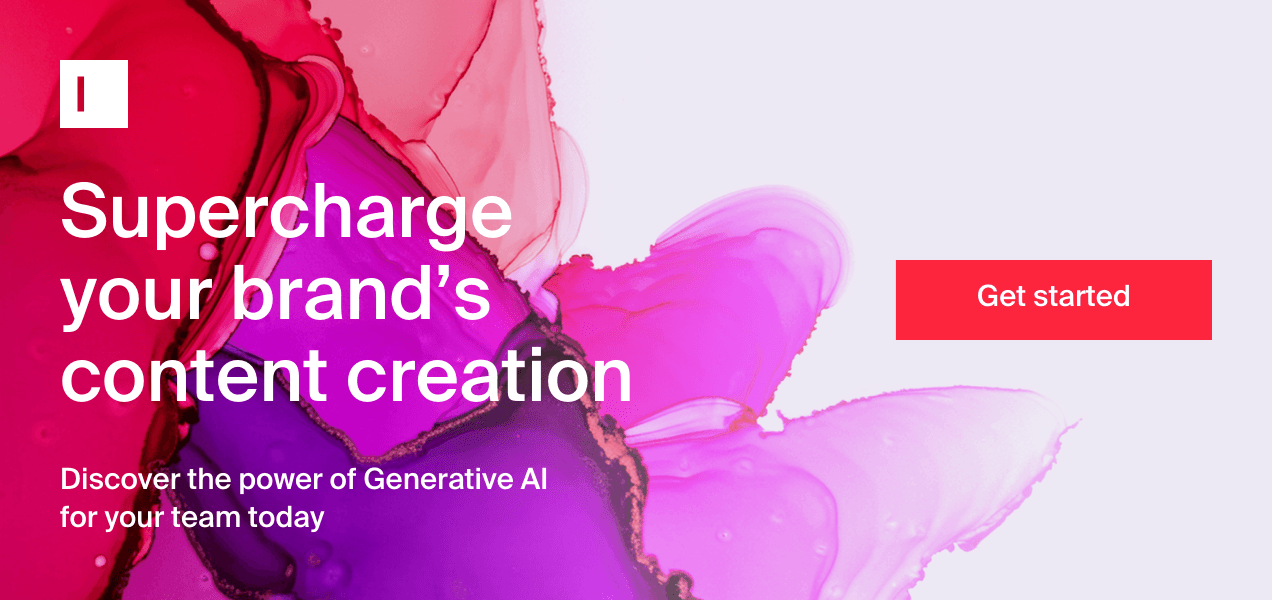
Share
Related articles

AI at Work
7 Generative AI Use Cases in Enterprise Marketing

Neelam Goswami · Content Marketing Associate
November 12th, 2024 · 15 min read

AI at Work
AI Personalization in Marketing - Creating Tailored Content for Diverse Audiences

Neelam Goswami · Content Marketing Associate
November 28th, 2024 · 11 min read
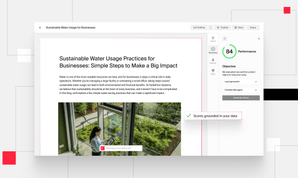
Product
Demystifying AI: Bringing Trust and Actionable Insights into Your Content Workflow

Saachi Shah · Product Manager
October 16th, 2024 · 5 min read
